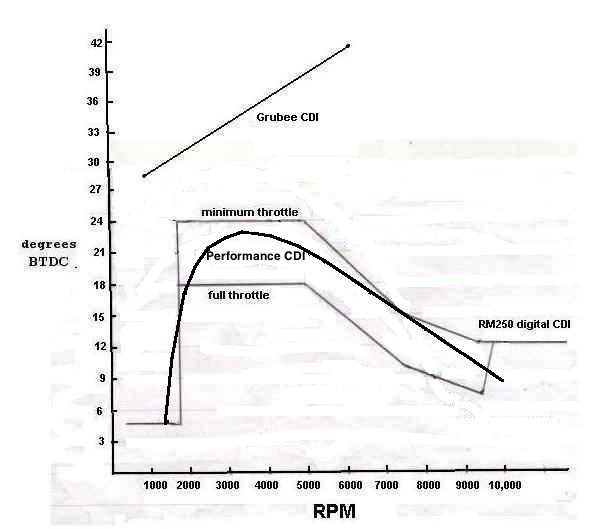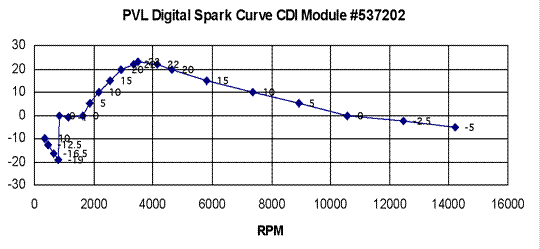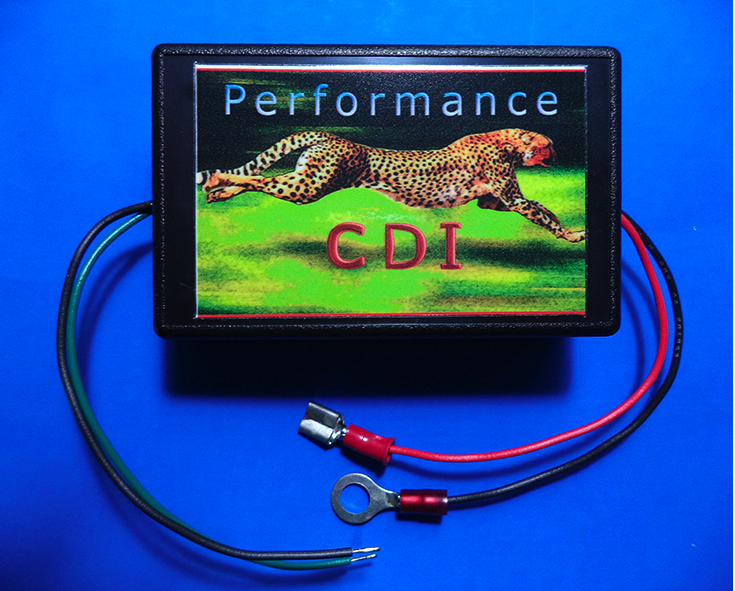
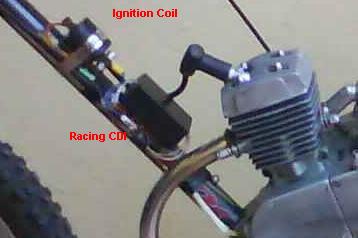 Performance CDI:
This is a true 2 stroke CDI designed specifically for use with the
Grubee engine. The amount of spark advance (in degrees before TDC) is
near perfect for this engine and its timing curve can be set by the
rider to best match the engine (stock or modified). Also the maximum
spark gap is more than three times what the stock CDI gives. (read more)
And the spark current is 50% more. This spark power
increase causes around a 10% power gain from the engine. This is
because of the bigger ignition coil that comes with this CDI.
From the research paper "Devices to improve the performance of a conventional two-stroke spark ignition engine" a 33% electrical spark power increase results in:
Here
is a digital timing curve from a PLV CDI, just as another example to
show that an advance/retard curve is standard for 2 strokes: Other Advantages: Reliability: The stock CDI/coil combo is cheaply made and prone to failure. The Performance CDI is well made and much more reliable. The stock overly advanced ignition causes too much compression at high rpm by igniting the fuel mixture too early. This is very hard on the stock bearings (connecting rod and crank bearings) which are rather weak. Higher RPMs: The Performance CDI increasingly retards (makes happen later) the spark timing at rpm's over 3600. At high RPM there is much more air/fuel turbulence which reduces the need for advanced ignition timing. (This is true of a small displacement engine whether or not the cylinder head has a squish band.) As a result of installing our CDI you will be able to run the engine to higher RPM (ie: higher speed). To take the maximum advantage from it you can use a rotary tool to raise the exhaust port and lower the intake port to get even more RPM and more speed without risk of damage. Aids High Compression Cylinder Heads: The higher the cylinder pressure of air/fuel, the higher the spark power needs to be to ignite it. If you modify your cylinder head for high compression or use an aftermarket high compression head then you are likely to have a significant amount of combustion instability and some misfiring if you don't also up the spark power. The High Performance CDI solves that problem. Also if the head has a squish band then you need to be able to adjust the timing because squish bands cause a more rapid burn which necessitates later ignition timing to keep the peak cylinder pressure occurring between 10 and 15 degrees after top center. 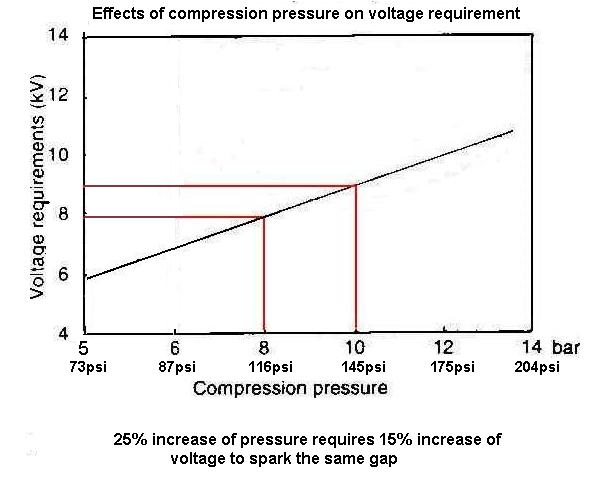 Aids Expansion Chamber: The Performance CDI increasingly retards the spark timing at RPM over 3600. An expansion chamber is not required for use with this CDI but there is an extra advantage with it. That advantage is an upper extension of the powerband. So if your pipe gives you an RPM range of increased power of 1500 then you may expect an extra 400 rpm of boosted power because of this CDI. Here's why: At high RPM the fuel/air turbulence is greatly increased which increases the burn rate. An increased burn rate causes the returning exhaust pressure wave to come back (from the final pipe cone) to the exhaust port too soon which hinders the entrance of the trailing amount of fuel/air intake charge into the cylinder which lowers engine power. This is remedied by retarding the ignition timing at high rpm's which is what the Performance CDI does. Making the ignition spark happen later allows the pressure wave to return at just the right time for maximum engine power (due to a maximized delivery ratio of fuel/air). Less Vibration: The Performance CDI reduces engine vibration at high RPM by retarding the timing. Reduction of the timing advancement to the correct amount keeps the engine from fighting against excess cylinder pressure each compression stroke which causes loss of power and increases vibration. You will see once this CDI is on your bike how much smoother it is at high RPM. Customer Testimonies: "Now there are no more misfires which were common with the stock coil, and about an extra 1500 rpm! Also a noticeable difference in acceleration and power as my engine no longer sputters along. It was a good investment, worth every penny!" "Micheal, I just came back from a test ride, and I am very pleased with your CDI's performance. The power feels smoother and it feels like I have more top end. The bike runs like I visioned it would when I started the build. I don't think I could ask more from a single cylinder. I am very happy, will spread the word, recommend it to everyone, and after the Death Race I hope you will get more orders when I beat the Morinis." "I want you to know that your CDI works GREAT! The motor pulls strongly at low and high RPM's Thank You!" "ALL my engines have had a consistent problem with bottom connecting rod bearing failure, but this was largely attributed to the standard CDI giving an ever increasing spark advance with increasing rpm's. Since fitting the Jaguar [Performance] CDI I have not had any more bearing failures; in my case, the only reason why all 7 engines failed. All these engines failed at around the same time; between 700 and 750 kilometers [around 450 miles] - surprisingly consistent, and my oil/fuel ratio is 20:1 with the old engines and the new engine. With the Jaguar CDI I now have approx 3,000 kilometers on the 8th engine which was rebuilt with a new crankshaft, although the new crankshaft is of the crowded roller design." Comparison to the standard Grubee CDI: On one long uphill I use for testing my bike went 20.5mph up it. 15 minutes later with the modified CDI the mph increased by 10% to 22.5! And at high RPM the standard CDI allowed too much engine vibration. The new CDI cut that in half for a much more pleasant ride. Copy Cat Competitors The Lightning CDI maintains the overly advanced timing curve which makes the engine run too hot and is hard on the bearings. Also, along with high engine compression, excessive ignition timing can cause detonation. The competitors may be OK for stock engines (power-wise) but is terrible for modified engines. The Performance CDI is better for both stock and modified engines because it is completely tunable to match the engine. Click here for a comparison graph showing timing curves. Rocket Racing Ignition: J.L. emailed me: "My bike is very limited with the Rocket Racing CDI presently installed. The unit is very ambient temperature dependent and only works well above 75 degrees F." Here is a picture of a piston with only two hours of running in an engine with detonation: 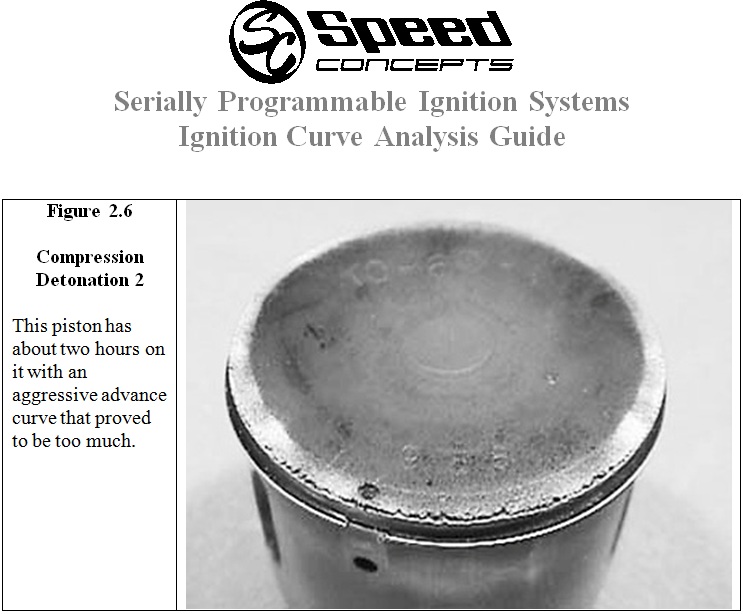 Although this CDI is great for racing engines, it is not just for racing. It is made to increase the overall performance and reliability of these Grubee engines. But Steven "magrider" DeZwart, with the Performance CDI on his bike, competed in the June 2012 motorized bicycle race at Willow Springs, California. He has a 66cc Happy Times engine with few changes to it other than the Performance CDI and an expansion chamber. He emailed me: "I got 1st place in the China 2 stroke category and 1st place in the Trophy Dash which was the 8 top finishers of the classes. I saw your ignition on many bikes. Great job with this. I raced with the stock head temping out at 345 degrees." Here's his picture before practice with the 1st place trophy inserted in the picture: 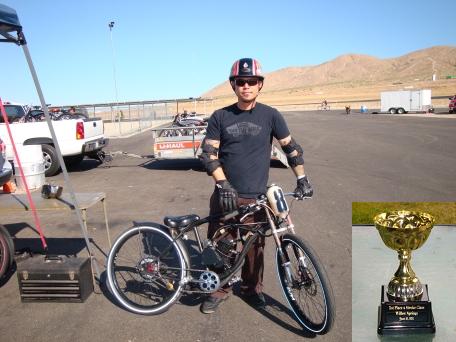 Why doesn't this CDI come with external switches instead of the on-board micro switches? Because you only have to make a few test runs to determine the optimum settings and thereafter you won't be messing with them. Also that kind of switch is prone to failure due to water intrusion which is why it is better in an enclosed box. What if I feel inadequate to properly set the switches to an optimal position? Then just leave the switch positions as they come because they are set for engines that haven't had their exhaust port raised for higher RPM. Other than having a weaker spark and more engine vibration why shouldn't I stick to the stock CDI? Because its excess ignition timing advance at high revs can cause excess engine heat (read more)
and wears out the crankshaft and conrod bearings too quick due to
excess combustion pressure because with the stock CDI the pressure
peaks around TDC instead of 10-15 degrees after TDC. Its peak is higher
because at TDC there is less volume between the piston and the head.
Less volume for the same amount of air/fuel being burned means more
pressure. Does it matter whether or not the engine is modified? Not at all. It improves performance of both modified and non-modified engines. But engines modified to rev higher will benefit even more. Click here to read about how to change the ports for higher RPM. How can I test it to see that it produces a hotter spark?
Just take out the spark plug, connect it to the spark plug cap, hold
the spark plug onto the cylinder head so that it is grounded, and with
dim lighting (best at night) push the motorbike and you will see the
actual spark. Do this same routine with the standard ignition system
before changing to this new system so you will have a point of
comparison. What about your competitors CDI that has very little ignition retard at high RPM? That only works well with low compression and the crappy standard carburetor which has no true idle circuit and does a poor job of atomizing the fuel. In such a scenario it takes longer for the fuel mixture to burn and so needs more spark advance. But anyone that wants true performance from these engines should do these three things: 1) install a good carburetor, 2) increase the engine compression, 3) install the Performance CDI. The more the fuel is atomized (due to good carburetion and engine turbulence) the quicker it burns which produces more engine power because a greater percentage of the burn happens after top dead center if the ignition timing is correct. For it to be correct you need to retard the spark at high RPM so that the peak cylinder pressure happens around 15 degrees ATDC. So getting a good carburetor and the Performance CDI go hand in hand. With a good carburetor you will also have easier starting and a stronger idle that isn't erratic. And you can adjust the jetting for more power, less fuel consumption (in case of too rich jetting from the standard carb), and a cleaner running spark plug. Shouldn't
ignition timing be advanced at high rpm since there is less time
available for combustion to peak at 10-15 degrees ATDC (the
ideal spot for peak pressure to occur)? Although there is
less time available, because of greater intake/transfer turbulence, the
combustion happens faster. Admittedly though the shorter combustion
time doesn't shorten as much as the shorter degrees time. There is a
balancing act going on with the correct ignition delay. Is the Performance CDI adequate for a highly modified racing engine also? Of course it is. This CDI is good for up to 10,000RPM. But higher than 9000 is not recommended since the transfer ports are small on these engines. It is possible to reach 10,000 but the power will be noticeably less than with an engine with larger transfer ports. And porting for that high an RPM kills low RPM power. My bike revs to 8500 and still has down low power for street use but I cheat by having a torque pipe I custom built. Is this the same as the "Jaguar CDI" I have read so much about on the forums? Yes it is but we had to change its name due to trademark regulations. What if I don't know how to solder? Then read these online soldering tutorials for beginners: How do I insulate the exposed connection afterwards? Included with the CDI is 4 pieces of heat shrink tubing (available also at Radio Shack). Please put the black heat shrink tubing on one of two wires before soldering them together. Then slide the tubing over the exposed solder connection and move the soldering iron back and forth over it so that the heat causes it to reduce its diameter and provide a tight seal over the metal. What if it stops working and I would rather troubleshoot it and fix it myself instead of sending it back for a replacement then what should I do? Go to this page for instructions.WARRANTY - If the Performance CDI or coil fails within 1 year of purchase then the failed part can be returned to JNMotors for a new replacement. Click here for installation instructions for the old Jaguar CDI with jumpers. Click here for other technical articles concerning the Grubee engine by "Jaguar" If JNM is out of stock you can order the CDI directly from Jaguar in South America for $50+shipping. Shipping takes 10 days and you have to buy your own high voltage ignition coil. Recommended is any Honda CR coil, new or used on EBay (if they offer a guarantee). I also recommend this new coil that has free shipping within the USA but it has a tall spark plug cap that you may want to replace with this one. (caps screw in/out of the wire) CCnow is the credit card processor Jaguar uses for payment processing. They don't take the money from your card till Jaguar provides the shipping tracking number to them, and if the package never arrives then they will refund your money so that there is no risk to you. "BioElectric" is my main business that uses CCnow and so it will appear on your charge. Click on the CCnow logo below to buy the Performance CDI from Jaguar:  |
